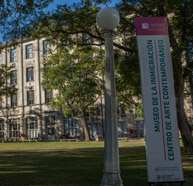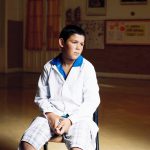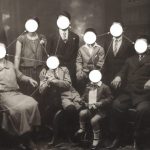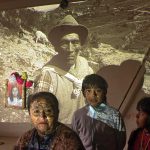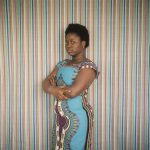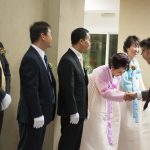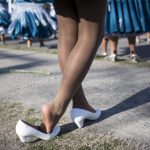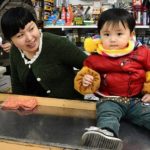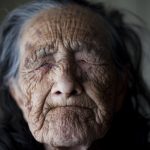-
WALKERS

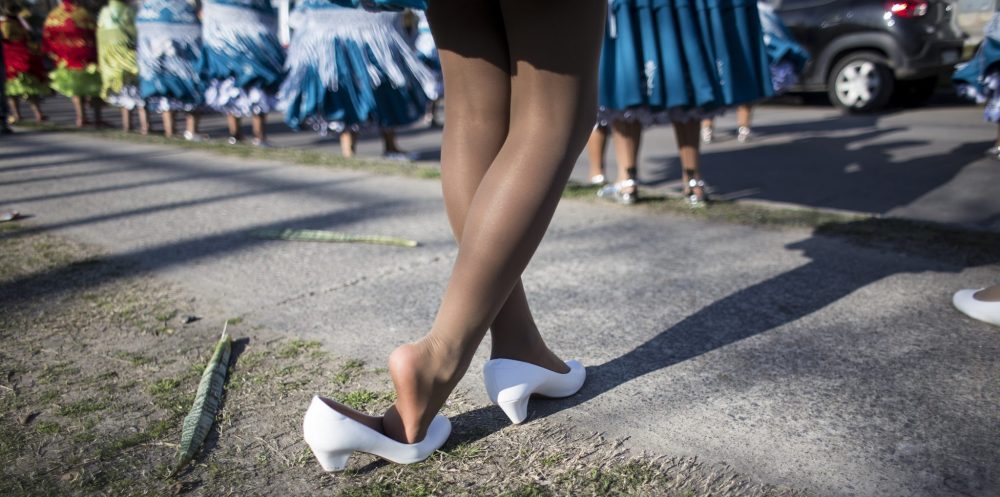
-
WALKERS

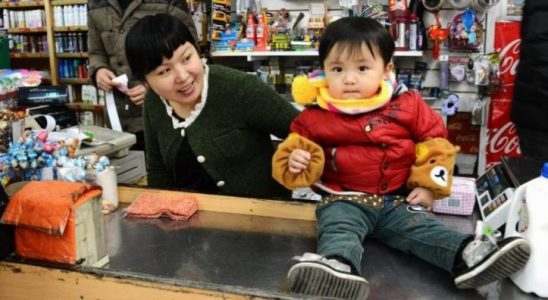
-
WALKERS

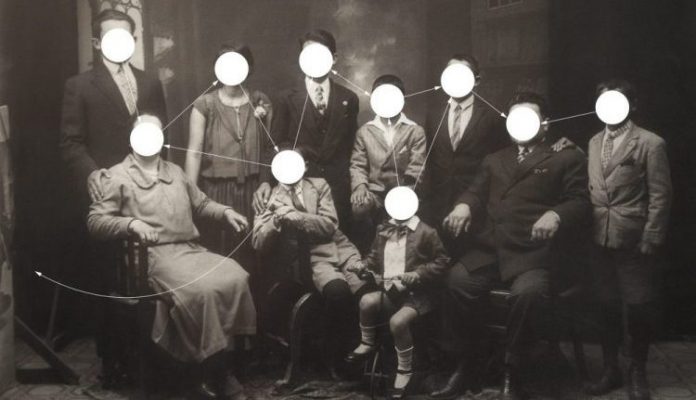
-
CURATORIAL TEXT
The issue of transits, migrations, exiles crosses in different ways the more or less recent history as much as the present. For UNTREF, occupying the former Immigrant Hotel, it represents not only the responsibility of caring for the tangible and intangible heritage that this entails, but also that of working, from different perspectives, on these issues.
Migrations and diversity are the face and cross of the same reality that we seek to approach with experiential montages, like those of the MUNTREF Immigration Museum or linked to contemporary art, such as those presented in the other rooms of this old building, trusting that the coexistence of perspectives will contribute to illuminate other aspects of reality.
In this way we believe it is opportune to add not only the most specialized views of historians, sociologists, artists or curators, but also those that may arise from an open call such as the one at the base of the Walkers (Caminantes) project, with which we were invited -in a broad way- to present photographs that reveal the diverse ways in which transits and migrations contribute to the conformation of a polyphonic culture.
The task of receiving the numerous proposals was followed by the selection carried out by the jury composed of Rodrigo Abd, Daniel Merle, Lena Szankay and Jorge Zuzulich, followed by the taking of a series of decisions linked to the type of narration that the curatorial team made up of Daniel Merle and Julieta Pestarino (both advanced students of the Master’s Degree in Curatorship in Visual Arts at UNTREF) with the collaboration of Jazmín Grinbaum in the design of the montage. The photos presented to the public in this exhibition were printed and framed as a vast repertoire of scenes captured by each of the photographers in their respective daily lives, which reflect the variety that integrates what we call a culture of mixture.
The public university contributes once again in the construction of communicating vessels with the community by building bridges between spaces and people making, as we like to affirm, each project a place for thought.
Aníbal Y. Jozami
Rector
UNTREF
Diana B. Wechsler
Deputy Director
MUNTREF
-
WORKS LIST
Collective Sado, Nazareno Ausa, Jasmine Bakalarz, Solange Baqués, Veronica Bellomo, Ezequiel Bluvstein, Omar Bogado, Gianni Bulacio, Paula Mariana Burd, Malena Cagna, CarlomanMacidiano Céspedes Riojas, Tali Elbert, Adan Jones, Alejandro Lipszyc, Jorge Mónaco, Silvio Moriconi, Daniel Muchiut, Alberto Natan, Walter Darío Nicoliello, Laura Ortego, Sergio Otaño, Mario Rodríguez, Vera Rosemberg, Ezequiel Sambresqui, Constanza Solórzano, Carlo Iván Rodríguez Cazares, Paola Natalia Olari Ugrotte.
Sado Collective
Living Culture
2018
Feast of the Virgin of Copacabana in the City of La Plata. The Bolivian collectivity and the persistence of their ancestral traditions.
Nazareno Ausa
Everything fits in seven suitcases
Guillermo Amador Padilla was a student leader. In 2009 he had to escape from Honduras after the coup d’état that overthrew the government of Manuel Zelaya. Since April 2011 he lives in Argentina with his wife and son.
Jasmine Bakalarz
Moses Ville (Santa Fe)
2015
Agricultural colony founded in 1889 by Jewish immigrants from Eastern Europe and Russia who escaped from the pogroms. A contemporary record of this historic village.
Solange Baqués
Inheritance
2018
Old age and my mother’s growing memory loss led me to go through my family history, my roots. Through a simple and intimate narrative, I travel through my parents’ house, their spaces and objects, documenting these stories so that they are not forgotten.
Veronica Bellomo
Pablo and Johana
2016
They were married in the Korean Church of the Full Gospel, located in Flores. In this Buenos Aires neighborhood lives the largest community of Koreans in Argentina, about 30,000 people.
Ezequiel Bluvstein
Anonymous Routes
2018
The Argentine Jewish community was born with the massive arrival of immigrants escaping hunger and persecution from Russia and Eastern Europe.
Omar Bogado
Autumn sun
2013
Through the photos I can feel their smells again, hear their voice, I can look at their colors again. She is my grandmother and has her origin in her skin.
Gianni Bulacio
Independence of Bolivia in Jujuy
Members of a fellowship of the Federation of Folkloric Sets and Bolivian Dances in Buenos Aires.
Paula Mariana Burd
Viale
My grandfather founded a general store there in 1908. Tracing this family history of immigrants, I first came to town in 1996.
Malena Cagna
Migrant
2015
Carrying stories from other lands, they came from different countries to the neighborhood of Villa Soldati, south of the Autonomous City of Buenos Aires. Migrant women who share their traditions and make them part of our culture.
Carloman Macidiano Céspedes Riojas
Mom’s Notes
2018
Olga has lived in Buenos Aires for 20 years, the distance with her family in Peru is overcome with long phone calls that last up to an hour.
Tali Elbert
Sheet 1, Sheet 2
2018
Reconstruction of my family tree. Act of repair from the listing of various supports obtained from the family archive.
Adan Jones
Migrant
2012-2013
People from all over the world who briefly chose Buenos Aires as a place to project themselves. A moment in constant human displacement
Alejandro Lipszyc
The emigrants
2002
These photographs were taken during 2002, in the midst of a deep economic and social crisis. People pose with their suitcases in front of their homes before leaving for the airport.
Jorge Monaco
Mennonites
2002-2010
Originating in the 16th century, they profess an austere life, with strong traditions associated with the Anabaptist Christian faith and isolated from society.
Silvio Moriconi
Seven thousand kilometers
2018
Stephen Amoakoene was one of the first Africans to settle in Rosario. He arrived from Ghana in 1999. In the photo he is hugged with his wife Nancy.
Daniel Muchiut
Bolivia
2008-2016
Portraits of the Bolivian community living in Chivilcoy. They mix their life with projected landscapes of Potosí, La Paz and Copacabana.
Alberto Natan
My neighbors
2015
They are Peruvian, I observe them from a small window of my kitchen in Centenario Park, exact center of the Autonomous City of Buenos Aires.
Walter Darío Nicoliello
Mennonites
2017
Stopped in time. Mennonites are a religious and ethnic group that originated in Zurich (Switzerland) in 1525. They are currently located in Nueva Esperanza, Guatrache, La Pampa.
Laura Ortego
Mekong River
2013
At the end of the 1970s, in response to a call from the United Nations, the civil-military dictatorship governing the country received a group of Lao refugees. Although the government did not fulfill its promise to give them land and work, today they continue to live in Argentina and in each of their daily actions they seek to keep their memory alive and rebuild a bridge with their native land, which they lost forever.
Sergio Otaño
Syncretism
2017
In October, the Bolivian community gathers to celebrate the feast in honor of the Virgin of Copacabana in the General San Martín del bajo Flores neighborhood.
Mario Rodriguez
My old, Galician from Lugo
1986
Antonia was homesick. She wanted to die on her land. Celestino escaped the war, and Spain remained a distant memory.
Vera Rosemberg
European dressmaker
2009
Ezekiel Sambresqui
Afrovisibility
2018
Migrants from Cuba, Guinea, United States of America, Argentina and Brazil.
Constanza Solórzano
Rihanna, a Dominican hairdresser in Buenos Aires
2015
A few steps from Plaza Miserere, the public-private border is erased and tensions arise: the difference is performative and frames political and aesthetic resistance.
Carlo Iván Rodríguez Cazares
Master builders
Bolivian migrants work on the construction of a building in Buenos Aires. There are 12 Bolivians and one Paraguayan who live and work in the same place.
Paola Natalia OlariUgrotte
Superchinos
2013-2014
The family between the public and the private. The upbringing of a new generation of Argentine Chinese. The thousand-year-old recipe just around the corner.
Serie Superchinos, inmigrantes chinxs criando a sus hijxs en el espacio semipúblico de los supermercados. Foto: Paola Olari Ugrotte.-
-
WORKS
Venue
Museum of Immigration